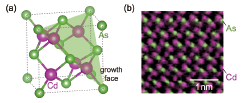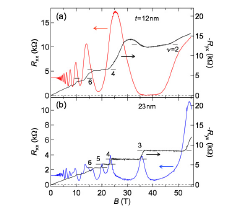Quantum Hall Effect in Topological Dirac Semimetal Cd3As2 Films
M. Uchida, M. Tokunaga, and M. Kawasaki
As crystalline materials of three-dimensional Dirac semimetal, Cd3As2 and Na3Bi have been suggested, and their unique electronic structures have been directly observed through angle-resolved photoemission and scanning tunneling spectroscopy. On the other hand, its quantum transport especially at high fields has been still elusive, because fabrication of high-quality Dirac semimetal films has been highly challenging unlike other topological materials. While Cd3As2 has long been known as a stable II–V type semiconductor, its film quality has been limited due to the necessity of low-temperature growth.

Fig. 1. (a) Primary crystal structure of topological Dirac semimetal Cd3As2. (b) Cross-sectional transmission electron microscopy image of a Cd3As2 film fabricated by high-temperature annealing. Cd and As atoms are periodically arranged without any clear crystallographic defects over a wide area.

Fig. 2. (a) High-field magnetotransport for a relatively thin Cd3As2 film (t = 12 nm) measured at T = 1.4 K. The numbers of the horizontal bars represent the filling factor ν, determining the degeneracy factor to be 2 from its increment. (b) Same scan for slightly thicker films (t = 23 nm). By contrast, the degeneracy is altered to 1 in this thicker film at high fields.
Here we report the observation quantum Hall effect and its thickness dependence by measuring high-quality Cd3As2 films fabricated by high-temperature annealing (Fig. 1) [1, 2]. Transport measurements up to 55 T were performed using a nondestructive pulse magnet with a pulse duration of 37 ms. Longitudinal resistance Rxx and Hall resistance Ryx were measured on the 60 μm-width Hall bar with flowing a DC current of I = 5 μA.
Figure 2 shows high-field magnetotransport for two Cd3As2 films with the same carrier density (n = 1 × 1018 cm-3) and different thicknesses (t = 12 and 23 nm). Shubnikov-de Haas (SdH) oscillations and plateau-like structures are resolved in longitudinal resistance Rxx and Hall resistance Ryx. As the field increases, integer quantum Hall states appear down to the quantum limit of filling factor ν = 2. Rxx finally becomes zero, and simultaneously, Ryx shows quantized values over wide field ranges. Temperature dependence of Rxx measured from 1.4 to 50 K can be well fitted with the standard Arrhenius plot, giving high activation energy of Δ = 19 K ascribed to the unusually high Fermi velocity in the Dirac semimetal. Absence of the half-integer plateaus suggests that a gap starts to open under the quantum confinement to the Dirac semimetal state. Furthermore, the degeneracy factor shows an interesting change depending on the film thickness; It is altered from 2 to 1 with increase of film thickness. Detailed analysis reveals that this change is attributed to spin splitting or g factor change, not to the lifting of other degeneracies, e.g., of valley or surface states. Reflecting the high Fermi velocity of the Dirac dispersion, the band gap sharply opens when the confinement thickness, giving rise to the drastic change of the g factor change observed in the quantum Hall effect.
Detailed electronic structures including subband splitting and gap opening are determined by analyzing the quantum transport depending on the confinement thickness. The demonstration of quantum Hall states in the high-quality Cd3As2 films opens a road to study high-field quantum transport in topological Dirac semimetal and its derivative phases. Combining electric gating, heterostructure fabrication, or chemical doping techniques to the high-field measurements will open possibilities for further studying quantized transport phenomena by tuning Fermi level, hybridization gap, or magnetic interaction.
References
- [1] M. Uchida, Y. Nakazawa, S. Nishihaya, K. Akiba, M. Kriener, Y. Kozuka, A. Miyake, Y. Taguchi, M. Tokunaga, N. Nagaosa, Y. Tokura, and M. Kawasaki, Nature Communications 8, 2274 (2017).
- [2] Y. Nakazawa, M. Uchida, S. Nishihaya, M. Kriener, Y. Kozuka, Y. Taguchi, and M. Kawasaki, Scientific Reports 8, 2244 (2018).
